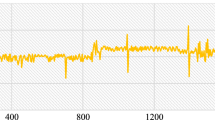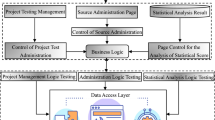Abstract
In order to improve the effect of physical education and training, this paper combines machine learning technology to identify sports training features and action prediction, and combines Internet of Things technology to process physical education and training data, and build a physical education and training system based on machine learning and Internet of Things. In order to solve some shortcomings of the original extreme learning machine, this paper gradually optimizes the hidden layer mapping and parameter optimization to further improve the accuracy of prediction. Moreover, this paper uses the Internet of Things technology to achieve long-term uninterrupted data collection, and after the data have been processed to a certain extent, an extreme learning machine is used to predict the situation of sports training. Finally, this paper designs experiments to verify the performance of the system. The research results show that the physical education and training system constructed in this paper have certain practical effects and can optimize the physical education and training process.













Similar content being viewed by others
References
Rein R, Memmert D (2016) Big data and tactical analysis in elite soccer: future challenges and opportunities for sports science[J]. Springerplus 5(1):1–13
Ridderinkhof KR, Brass M (2015) How kinesthetic motor imagery works: a predictive-processing theory of visualization in sports and motor expertise[J]. J Physiol-Paris 109(1–3):53–63
Mulligan D, Lohse KR, Hodges NJ (2016) An action-incongruent secondary task modulates prediction accuracy in experienced performers: evidence for motor simulation[J]. Psychol Res 80(4):496–509
Khudolii OM, Ivashchenko OV, Iermakov SS et al (2016) Computer simulation of junior gymnasts’ training process[J]. Sci Gymnast J 8(3):215–228
Tivener KA, Gloe DS (2015) The effect of high-fidelity cardiopulmonary resuscitation (CPR) simulation on athletic training student knowledge, confidence, emotions, and experiences[J]. Athl Train Educ J 10(2):103–112
Ivashchenko OV, Kapkan OO (2015) Simulation of process of 14–15 years old girls’ training of light athletic and gymnastic exercises[J]. Pedag, Psychol, Med-Biol Probl Phys Train Sports 8:32–40
Owen PD, King N (2015) Competitive balance measures in sports leagues: the effects of variation in season length[J]. Econ Inq 53(1):731–744
Yang J (2019) The Simulation of table tennis during the course of sports[J]. Carib J Sci 52(4):1561–1564
Bulat M, Can NK, Arslan YZ et al (2019) Musculoskeletal simulation tools for understanding mechanisms of lower-limb sports injuries[J]. Curr Sports Med Rep 18(6):210–216
Payne T, Mitchell S, Bibb R et al (2015) The evaluation of new multi-material human soft tissue simulants for sports impact surrogates[J]. J Mech Behav Biomed Mater 41(5):336–356
Juan Pablo ngel-López, Nelson Arzola de la Peńa. (2015) Kinematic hand analysis using motion capture technology[J]. IFMBE proceedings, 49(6):257-260.
Kim MK, Kim TY, Lyou J (2015) Performance improvement of an AHRS for motion capture[J]. J Institute Control 21(12):1167–1172
Zhou ZM, Chen ZW (2015) A survey of motion capture data earning as high dimensional time series[J]. Int J Multimed Ubiquitous Eng 10(9):17–30
Khan MA (2016) Multiresolution coding of motion capture data for real-time multimedia applications[J]. Multimed Tools App 76(15):1–16
Puupponen A, Wainio T, Burger B et al (2015) Head movements in finnish sign language on the basis of motion capture data: a study of the form and function of nods, nodding, head thrusts, and head pulls[J]. Sign Lang Linguist 18(1):41–89
Lee Y, Yoo H (2016) Low-cost 3D motion capture system using passive optical markers and monocular vision[J]. Optik Int J Light Electron Optics 130(2):1397–1407
Rahman MM (2017) Analysis of finger movements of a pianist using magnetic motion capture system with six dimensional position sensors[J]. Trans Virtual Real Soc Japan 15(3):243–250
Park SW, Park HS, Kim JH et al (2015) 3D displacement measurement model for health monitoring of structures using a motion capture system[J]. Measurement 59(5):352–362
Giannetti R, Petrella A, Bach J et al (2017) In vivo bone position measurement using high-frequency ultrasound validated with 3-D optical motion capture systems: a feasibility study[J]. J Med Bio Eng 37(7):1–8
Zhang H, Wang L, Chu S et al (2016) Application of optical motion capture technology in power safety entitative simulation training system[J]. Optics Photonics J 06(8):155–163
Wang SK, Xie H, Hu B (2014) Research on protection property of running sportswear fabrics based on 3-D motion capture system[J]. Textiles Light Indus Sci Technol 3(2):57–62
Miura T, Kaiga T, Shibata T et al (2017) Low-dimensional feature vector extraction from motion capture data by phase plane analysis[J]. J Info Process 25(6):884–887
Frost DM , Beach TAC , Campbell TL et al. Can the Functional Movement Screen™ be used to capture changes in spine and knee motion control following 12 weeks of training?[J], Physical Therapy in Sport, 2016, 23(6):50-57.
Author information
Authors and Affiliations
Corresponding author
Ethics declarations
Conflict of interest
The authors declare that they have no competing interest.
Additional information
Publisher's Note
Springer Nature remains neutral with regard to jurisdictional claims in published maps and institutional affiliations.
Rights and permissions
About this article
Cite this article
Wang, C., Du, C. Optimization of physical education and training system based on machine learning and Internet of Things. Neural Comput & Applic 34, 9273–9288 (2022). https://doi.org/10.1007/s00521-021-06278-y
Received:
Accepted:
Published:
Issue Date:
DOI: https://doi.org/10.1007/s00521-021-06278-y




